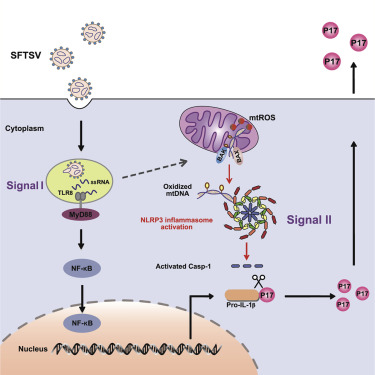Cell Reports ( IF 7.5 ) Pub Date : 2020-03-31 , DOI: 10.1016/j.celrep.2020.02.105 Shufen Li , Hao Li , Yu-Lan Zhang , Qi-Lin Xin , Zhen-Qiong Guan , Xi Chen , Xiao-Ai Zhang , Xiao-Kun Li , Geng-Fu Xiao , Pierre-Yves Lozach , Jun Cui , Wei Liu , Lei-Ke Zhang , Ke Peng

|
Severe fever with thrombocytopenia syndrome (SFTS) virus (SFTSV) is an emerging tick-borne virus that carries a high fatality rate of 12%–50%. In-depth understanding of the SFTSV-induced pathogenesis mechanism is critical for developing effective anti-SFTS therapeutics. Here, we report transcriptomic analysis of blood samples from SFTS patients. We observe a strong correlation between inflammatory responses and disease progression and fatal outcome. Quantitative proteomic analysis of SFTSV infection confirms the induction of inflammation and further reveals virus-induced mitochondrial dysfunction. Mechanistically, SFTSV infection triggers BCL2 antagonist/killer 1 (BAK) upregulation and BAK/BCL2-associated X (BAX) activation, leading to mitochondrial DNA (mtDNA) oxidization and subsequent cytosolic release. The cytosolic mtDNA binds and triggers NLRP3 inflammasome activation. Notably, the BAK expression level correlates with SFTS disease progression and fatal outcome. These findings provide insights into the clinical features and molecular underpinnings of severe SFTS, which may aid in patient care and therapeutic design, and may also be conserved during infection by other highly pathogenic viruses.
中文翻译:

SFTSV感染诱导依赖BAK / BAX的线粒体DNA释放以触发NLRP3炎性体激活。
血小板减少症候群(SFTS)病毒(SFTSV)引起的严重发烧是一种新兴的tick传病毒,病死率高达12%–50%。深入了解SFTSV诱导的发病机理对于开发有效的抗SFTS治疗剂至关重要。在这里,我们报告了SFTS患者血液样本的转录组分析。我们观察到炎症反应与疾病进展和致命结果之间的密切相关。SFTSV感染的定量蛋白质组学分析证实了炎症的诱导,并进一步揭示了病毒引起的线粒体功能障碍。从机制上讲,SFTSV感染会触发BCL2拮抗剂/杀手1(BAK)上调和BAK / BCL2相关的X(BAX)激活,导致线粒体DNA(mtDNA)氧化并随后释放胞质。胞质mtDNA结合并触发NLRP3炎性体激活。值得注意的是,BAK表达水平与SFTS疾病进展和致命结果相关。这些发现提供了对严重SFTS的临床特征和分子基础的见解,这可能有助于患者护理和治疗设计,并且在其他高致病性病毒感染期间也可能得到保留。











































 京公网安备 11010802027423号
京公网安备 11010802027423号